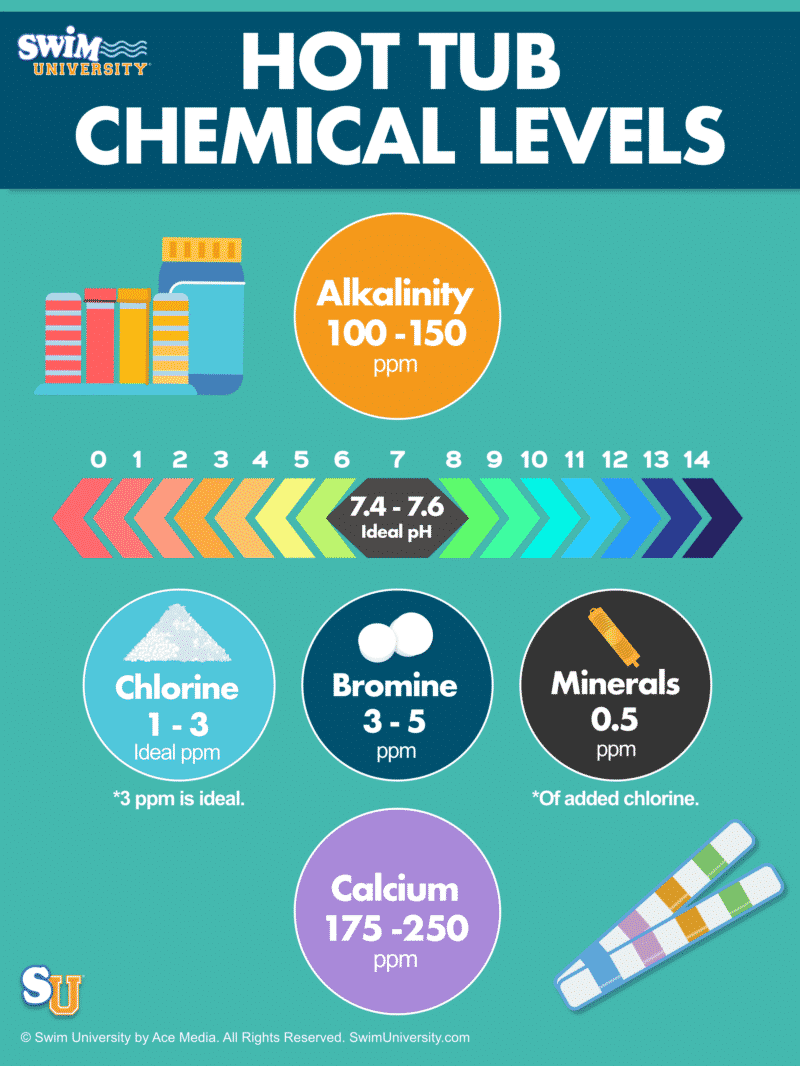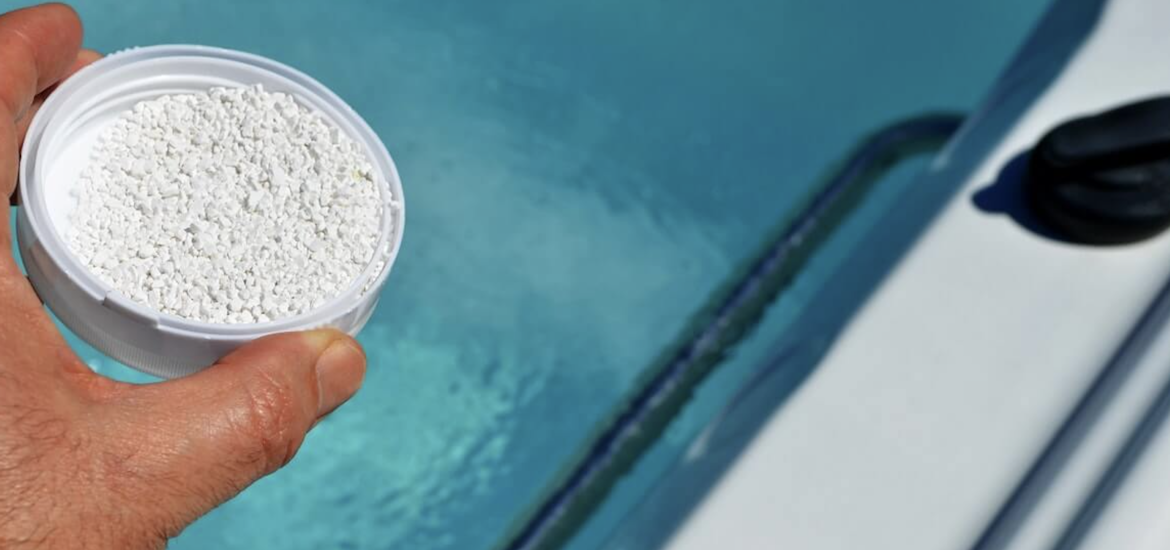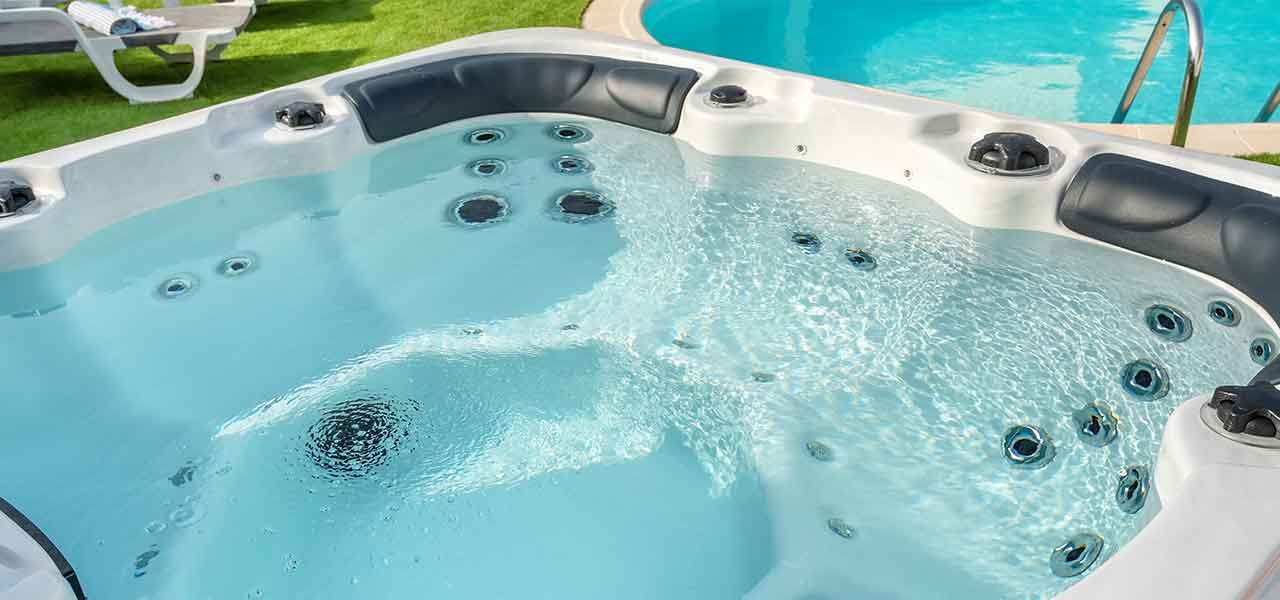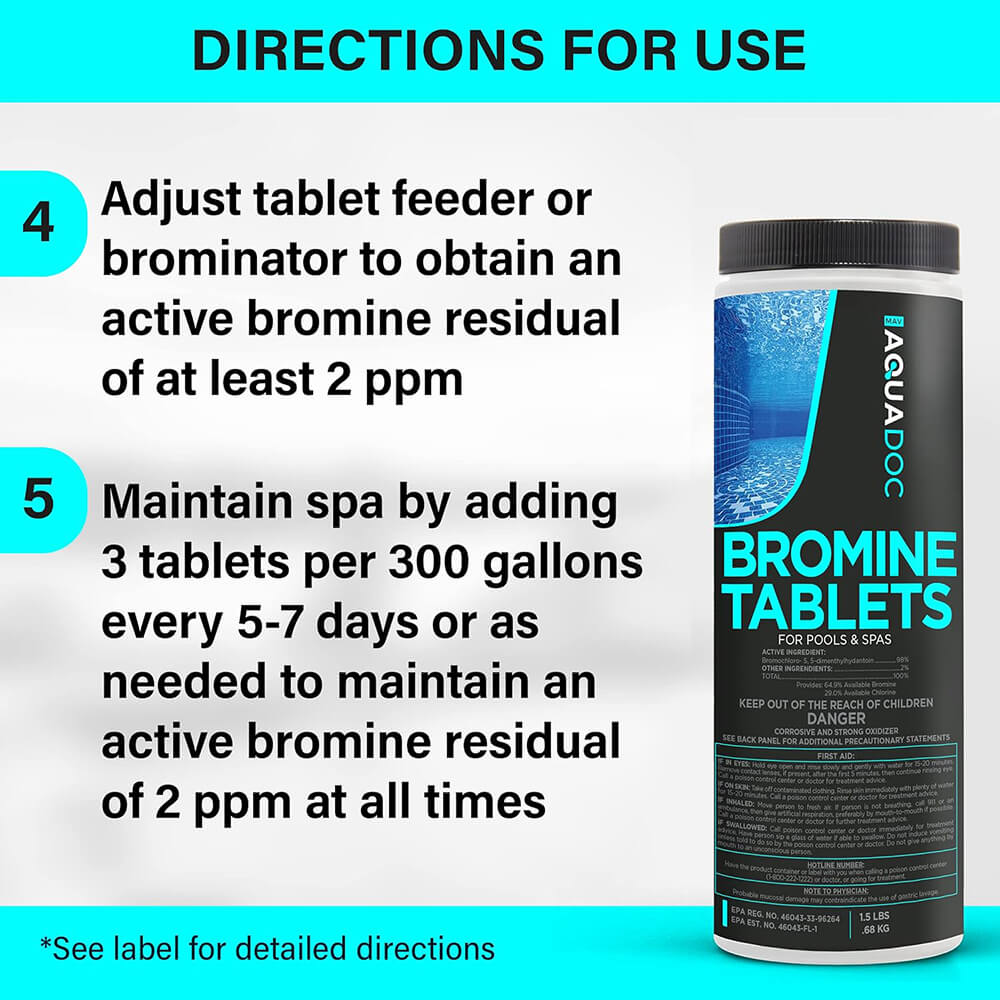Bromine, a cousin to chlorine is a reliable and choice chemical that is the perfect solution for keeping your hot tub water crystal clear, and free of any bacteria, and contaminants that when used properly can be the best choice for Hot Tub owners. How Much Bromine Do You Put in a Hot Tub?
Hot Tub bromine levels should always be between 3-5 ppm (parts per million). How frequently you need to add bromine will depend on your usage & bathing habits. It could be daily, every two to three days, or weekly for 3mg/l add 12g per 1500 liters. Usually double the amount compared to Chlorine use.
A sanitizer deactivates and kills pathogens, kills bacteria, and renders viruses harmless. An oxidizer breaks down organic waste products, like ammonia, into their components. Bromine is, like chlorine, both a sanitizer and an oxidizer.
How Much Bromine Do You Put in a Hot Tub
Your hot tub bromine level should always be between 3-5 ppm (parts per million). How frequently you need to add bromine will depend on your usage and bathing habits. It could be daily, every two to three days, or weekly. For 3mg/l add 12g per 1500 litres of water. You use double the of Bromine than Chlorine in a Hot Tub.

The amount of bromine you need to put in a hot tub depends on several factors, including the size of the tub, the water volume, and the bromine concentration of the products you’re using. Here’s a general guideline:
Start-up dosage: When you initially fill your hot tub with water, you’ll typically add a higher dose of bromine to establish a sanitizer level. This initial dosage can vary depending on the product you’re using, but it’s usually around 3-5 tablets or 1-2 ounces of granular bromine per 500 gallons of water.
Maintenance dosage: After the initial treatment, you’ll need to maintain a consistent level of bromine in the water to keep it sanitized. This usually involves adding bromine tablets or granules regularly, depending on the manufacturer’s instructions. A common maintenance dosage is around 1-2 tablets per 500 gallons of water added every few days, or as needed to maintain a bromine level of 3-5 ppm (parts per million).
Testing: It’s important to regularly test the bromine level in your hot tub water using test strips or a test kit. This will help you determine if you need to add more bromine to maintain the proper level for sanitization.
Adjustments: Factors such as hot tub usage, bather load, and environmental conditions can affect the bromine level, so you may need to adjust the dosage accordingly.
Always follow the manufacturer’s instructions for the specific bromine product you’re using, as dosages can vary between different brands and formulations. Additionally, be sure to handle bromine products safely and store them properly to prevent accidents or exposure.
To use bromine in a hot tub, you need to add bromine tablets or granules to the water, either directly or through a dispenser or a floater. You also need to shock the water with bromine granules when you fill the hot tub for the first time or after a water change of the hot tub.
One rule that is very important for the use of Bromine in Hot Tubs, is you should not mix bromine with chlorine sanitizer, but you can use chlorine shock with bromine sanitizer. You can get in the hot tub right away after adding bromine tablets, but you should wait at least 30 minutes after adding bromine powder or liquid.
Pool stores sometimes recommend bromine tablets for large home pools when there is a spa connected but for stand-alone spas, bromine is simply too concentrated. Bromine is designed to be used for cold spas, not heated spas. With heat, the bromine chemicals can react and cause harm to both you and your spa.
What is Bromine
Bromine is a chemical element with the symbol Br and atomic number 35. It is in the halogen group of the periodic table, along with fluorine, chlorine, iodine, and astatine.  Bromine is a reddish-brown liquid at room temperature with a strong, unpleasant odor. It is corrosive and highly reactive, often used as a disinfectant and sanitizer in various industrial and commercial applications.
Bromine is a reddish-brown liquid at room temperature with a strong, unpleasant odor. It is corrosive and highly reactive, often used as a disinfectant and sanitizer in various industrial and commercial applications.
In the context of hot tubs and swimming pools, bromine is commonly used as a sanitizer to kill bacteria, viruses, and other harmful microorganisms in the water.
It works by releasing bromine ions that destroy organic contaminants, keeping the water clean and safe for bathing. Bromine is preferred over chlorine by some users due to its greater stability in hot water and lower odor, although both are effective sanitizers when used properly.
Bromine can also be found naturally in seawater and certain salt deposits, as well as in small amounts in some minerals and volcanic springs. It has various industrial uses, including the production of flame retardants, agricultural chemicals, pharmaceuticals, and dyes. Despite its utility, bromine must be handled with care due to its corrosive and reactive nature.
How Does Bromine Work
Should I Use Bromine Tablets Or Granules
The choice between bromine tablets and granules depends on your personal preference, convenience, and specific requirements. Here’s a comparison to help you decide:
- Bromine Tablets:
- Convenience: Bromine tablets are easy to use and require minimal effort for dosing. Simply add the tablets to a floating dispenser or feeder, and they will gradually dissolve, releasing bromine into the water.
- Slow release: Tablets provide a slow, consistent release of bromine, maintaining a stable sanitizer level in the water over time. This can be convenient for maintaining consistent water quality with less frequent dosing.
- Suitable for automation: Bromine tablet feeders can be integrated into automated hot tub systems, allowing for hands-free sanitation.
- pH stability: Bromine tablets tend to have less impact on pH levels compared to bromine granules, which can help maintain balanced water chemistry.
-

Bromine Granules Bromine Granules:
- Rapid dissolving: Bromine granules dissolve quickly in water, providing a fast-acting sanitizer boost when needed. This can be advantageous for shock treatments or addressing sudden increases in bather load.
- Flexibility: Granules allow for more precise dosing, making it easier to adjust bromine levels as needed based on water testing results and environmental conditions.
- No residue: Unlike bromine tablets, which can leave behind undissolved residue in the hot tub, bromine granules dissolve completely, leaving no residue or potential clogging in the filtration system.
- Suitable for small spas: Bromine granules are particularly well-suited for smaller hot tubs or spas where using a floating dispenser may not be practical.
Ultimately, both bromine tablets and granules are effective for sanitizing hot tub water, so the choice comes down to your preference for ease of use, dosing flexibility, and specific requirements. Some hot tub owners may even use a combination of both tablets and granules, using tablets for regular maintenance and granules for shock treatments or adjustments. Whichever option you choose, be sure to follow manufacturer instructions for proper dosing and safety precautions.
Shocking your Hot Tub
To shock your hot tub, the easiest thing to do is usually to just add a “shock” dose of the same chlorine granules you use to sanitize your spa (the SpaGuard ones I linked above are a sanitizer and an oxidizer in one).

This should be done at least weekly, or more often depending on how much your tub is used. Remember, just like regular chlorine use, the number of bathers in your hot tub will help to determine the right frequency.
Shocking your hot tub is an essential part of regular maintenance to ensure clean and safe water for soaking. Shocking, also known as oxidizing, helps eliminate organic contaminants, bacteria, and algae that may have built up in the water despite regular sanitization efforts.
To shock your hot tub, you’ll typically use a shock treatment product specifically designed for hot tubs, which often contain a high concentration of chlorine or non-chlorine oxidizers. The process involves adding the shock treatment directly to the water, usually in the evening or when the hot tub is not in use, and allowing it to circulate for several hours or overnight. This helps break down and neutralize organic waste, restoring water clarity and freshness.
It’s important to follow the manufacturer’s instructions for the specific shock treatment product you’re using, including dosage and wait times, to ensure effective results without over-treating the water. Additionally, be sure to test the water regularly to maintain proper chemical balance and adjust shock treatments as needed based on usage and environmental factors. Regularly shocking your hot tub will help keep the water clean, clear, and inviting for enjoyable soaking experiences.
Follow this List:
- Choose a suitable shock treatment product specifically designed for hot tubs.
- Ensure the hot tub’s filtration system is running.
- Follow the manufacturer’s instructions for the specific shock treatment product regarding dosage and application method.
- Typically, shock treatments are added directly to the water in the evening or when the hot tub is not in use.
- Allow the shock treatment to circulate in the water for several hours or overnight.
- Test the water regularly using test strips or a test kit to monitor chemical levels.
- Adjust shock treatments as needed based on usage and environmental factors to maintain proper chemical balance.
- Shocking your hot tub regularly helps eliminate organic contaminants, bacteria, and algae, ensuring clean and safe water for soaking.
- Remember to handle shock treatment products safely and store them properly to prevent accidents or exposure.
- Enjoy clean, clear, and inviting water for enjoyable soaking experiences.
How to Raise Bromine Level in Pool?
- Shock the pool if the bromine level falls below 2.0 ppm
- Increase the dial setting on Brominators
- Add pucks to floaters
- Open bleeders on pool floaters
- Increase the number of pucks in skimmers
- Lengthen the pool’s pump run time
- Keep chemical water balance in check..………………………………………………….. Read more
Bromine Hot Tub Danger
Bromine tablets shouldn’t be used in your spa. When you have too high a concentration of bromine in your spa, your sanitizer will begin to eat away more than just bacteria.
When heat mixes with bromine, not only can you damage your spa components such as heaters and jets, but you can also cause damage to yourself and anyone else in your spa.
The use of bromine in your spa could result in skin irritation such as rashes eczema, and eye pain. The price of a clean spa is not worth the chemical soup that you will be soaking in.
Bromine is commonly used as a sanitizer in hot tubs to kill bacteria and other harmful microorganisms. However, there are potential dangers associated with bromine if not handled properly. Here’s a paragraph outlining some of these dangers: 
“While bromine is effective at sanitizing hot tub water, improper handling or dosage can pose risks to both health and equipment. Overexposure to bromine can cause skin and eye irritation, respiratory problems, and even allergic reactions in some individuals. Inadequate ventilation during the application of bromine products can lead to harmful fumes, exacerbating these risks. Additionally, using too much bromine or mixing it with incompatible chemicals can result in chemical imbalances, corrosion of hot tub components, and damage to surfaces.
To mitigate these dangers, it’s crucial to follow manufacturer guidelines for bromine usage, maintain proper ventilation, regularly test water chemistry, and store bromine products safely away from other chemicals. By practicing responsible hot tub maintenance and handling, users can enjoy the benefits of bromine sanitation without unnecessary risks.”
If you have been exposed to bromine tablets over a long period, it can also be responsible for more long-term health conditions. Your skin is porous and absorbent. Imagine what harm you could do by soaking in your spa long-term.
Bromine has been linked to irregular amounts of iodine in people and this can lead to conditions such as hypothyroidism and an overload of chemicals in your nervous system. In severe cases of high levels of bromine exposure, can result in reduced appetite, abdominal cramps, and fatigue.
What are the Differences Between Bromide Vs Chlorine in a Pool?
- Chlorine(Cl) works faster to kill contaminants but for a shorter time, as it dissipates faster.
- Bromine(Br) a more stable chemical kills contaminants more slowly but for a longer period & can help keep H2O chemistry more balanced…………………………. Read more

References:
Outdoor Living-Bromine Hot Tub Maintenance
FAQ’s
What is the ideal bromine level for a hot tub? A: The ideal bromine level for a hot tub typically falls within the range of 3-5 parts per million (ppm). This level ensures effective sanitization without irritating bathers’ skin and eyes.
How often should I add bromine to my hot tub? A: The frequency of bromine addition depends on factors such as hot tub usage, bather load, and environmental conditions. In general, bromine should be added regularly to maintain a consistent sanitizer level, typically every few days or as needed based on water testing results.
Can I use bromine tablets and chlorine together in my hot tub? A: While bromine and chlorine are both effective sanitizers, it’s generally not recommended to use them together in the same hot tub. Mixing bromine and chlorine can lead to chemical reactions and produce undesirable byproducts. It’s best to choose one sanitizer and stick with it for consistent results.
How do I lower bromine levels in my hot tub if they’re too high? A: To lower bromine levels in your hot tub, you can stop adding bromine products, increase water circulation, dilute the water with fresh water, use an oxidizer, add activated carbon, or use hydrogen peroxide. Regular testing and monitoring are essential to track the progress of lowering bromine levels.
